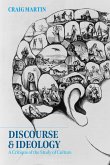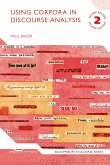Dr J. R. Martin (Australia University of Sydney), David Rose (Australia University of Sydney)
Working with Discourse
Meaning Beyond the Clause
Dr J. R. Martin (Australia University of Sydney), David Rose (Australia University of Sydney)
Working with Discourse
Meaning Beyond the Clause
- Broschiertes Buch
- Merkliste
- Auf die Merkliste
- Bewerten Bewerten
- Teilen
- Produkt teilen
- Produkterinnerung
- Produkterinnerung
Aims to present an accessible set of analytic tools that can be used to explore how speakers and writers construe meaning through discourse. These techniques are introduced through analyses of spoken, written and visual texts that focus on truth and reconciliation in post-apartheid South Africa.
Andere Kunden interessierten sich auch für
![Research Methods for Classroom Discourse Research Methods for Classroom Discourse]() Dr Jenni Ingram (UK University of Oxford)Research Methods for Classroom Discourse42,99 €
Dr Jenni Ingram (UK University of Oxford)Research Methods for Classroom Discourse42,99 €![Working Effectively With Your Teaching Assistant Working Effectively With Your Teaching Assistant]() Sara AlstonWorking Effectively With Your Teaching Assistant27,99 €
Sara AlstonWorking Effectively With Your Teaching Assistant27,99 €![Teaching Shakespeare with Purpose Teaching Shakespeare with Purpose]() Professor Ayanna Thompson (USA Arizona State University)Teaching Shakespeare with Purpose37,99 €
Professor Ayanna Thompson (USA Arizona State University)Teaching Shakespeare with Purpose37,99 €![Discourse and Ideology Discourse and Ideology]() Craig Martin (USA St Thomas Aquinas College)Discourse and Ideology36,99 €
Craig Martin (USA St Thomas Aquinas College)Discourse and Ideology36,99 €![The Discourse of Online Consumer Reviews The Discourse of Online Consumer Reviews]() Dr Camilla Vasquez (USA University of South Florida)The Discourse of Online Consumer Reviews50,99 €
Dr Camilla Vasquez (USA University of South Florida)The Discourse of Online Consumer Reviews50,99 €![Using Corpora in Discourse Analysis Using Corpora in Discourse Analysis]() Paul Baker (UK Lancaster University)Using Corpora in Discourse Analysis40,99 €
Paul Baker (UK Lancaster University)Using Corpora in Discourse Analysis40,99 €![50 Fantastic Things to Do with Squidgy Stuff 50 Fantastic Things to Do with Squidgy Stuff]() Kirstine Beeley50 Fantastic Things to Do with Squidgy Stuff22,99 €
Kirstine Beeley50 Fantastic Things to Do with Squidgy Stuff22,99 €-
-
-
Aims to present an accessible set of analytic tools that can be used to explore how speakers and writers construe meaning through discourse. These techniques are introduced through analyses of spoken, written and visual texts that focus on truth and reconciliation in post-apartheid South Africa.
Produktdetails
- Produktdetails
- Verlag: Bloomsbury Publishing PLC
- 2 ed
- Seitenzahl: 376
- Erscheinungstermin: 31. Mai 2007
- Englisch
- Abmessung: 234mm x 156mm x 20mm
- Gewicht: 578g
- ISBN-13: 9780826488503
- ISBN-10: 0826488501
- Artikelnr.: 21767254
- Herstellerkennzeichnung
- Libri GmbH
- Europaallee 1
- 36244 Bad Hersfeld
- gpsr@libri.de
- Verlag: Bloomsbury Publishing PLC
- 2 ed
- Seitenzahl: 376
- Erscheinungstermin: 31. Mai 2007
- Englisch
- Abmessung: 234mm x 156mm x 20mm
- Gewicht: 578g
- ISBN-13: 9780826488503
- ISBN-10: 0826488501
- Artikelnr.: 21767254
- Herstellerkennzeichnung
- Libri GmbH
- Europaallee 1
- 36244 Bad Hersfeld
- gpsr@libri.de
J. R. Martin
Chapter 1 Interpreting social discourse
1.0 An invitation
1.1 A framework for discussion
1.2 Genre
1.3 Language, power and ideology
1.4 How this book is organised
1.5 How to use this book
Chapter 2 APPRAISAL - negotiating attitudes
2.0 Negotiating attitudes
2.1 Kinds of attitudes
2.2 Amplifying attitudes
2.3 Sources of attitudes
2.4 Prosody and genre
2.5 More detail on kinds of attitude
Chapter 3 IDEATION - representing experience
3.0 Representing experience
3.1 Sequences of meanings
3.2 Doing - focusing on activities
3.3 Being - focusing on entities
3.4 Classifying and describing within elements
3.5 Ways of participating
3.6 Building up a picture - taxonomic relations
3.7 Types of taxonomic relations
3.8 Re-construing experience - ideational metaphor
Chapter 4 conjunction - connecting events
4.0 The logic of discourse
4.1 Four kinds of logic
4.3 Connecting arguments
4.4 Continuatives
4.5 Countering our expectations
4.6 Conjunction resources in full
4.7 Displaying connections - conjunction analysis
4.8 Logical metaphor
Chapter 5 IDENTIFICATION - tracking participants
5.0 Keeping track
5.1 Who's who? - identifying people
5.2 What's what? - identifying things
5.3 Where to look?
5.4 Tracking and genre
5.5 Identification systems in full
Chapter 6 PERIODICITY - information flow
6.0 Waves of information
6.1 Little waves - Themes and News
6.2 Bigger waves - hyperThemes and hyperNews
6.3 Tidal waves - macroThemes, macroNews, and beyond
6.4 How texts grow - hierarchies and series
6.5 Hard reading
6.6 A note on headings
6.7 Texture - phasing discourse systems
Chapter 7 NEGOTIATION
7.1 Interacting in dialogue
7.2 Exchanging roles - speech function
7.3 speech function and mood
7.4 Responding to
7.5 Sequencing moves - exchange structure
7.6 Interrupting exchanges - tracking and challenging
7.7 Extended exchanges - move and exchange complexes
7.8 Negotiation & beyond
Chapter 8 TACKLING A TEXT
8.1 Getting going
8.2 Outside-in
8.3 Inside-out
8.4 Inauguration day - from past to present
8.5 The Cost of Courage - from domination to freedom
8.6 The Meaning of Freedom - from self to community
8.7 Reprise
Chapter 9 CONNECTIONS
9.1 Context (register and genre)
9.2 Data
9.3 Critical Discourse Analysis (CDA)
9.4 Multimodal Discourse Analysis (MDA)
9.5 Voices
References
1.0 An invitation
1.1 A framework for discussion
1.2 Genre
1.3 Language, power and ideology
1.4 How this book is organised
1.5 How to use this book
Chapter 2 APPRAISAL - negotiating attitudes
2.0 Negotiating attitudes
2.1 Kinds of attitudes
2.2 Amplifying attitudes
2.3 Sources of attitudes
2.4 Prosody and genre
2.5 More detail on kinds of attitude
Chapter 3 IDEATION - representing experience
3.0 Representing experience
3.1 Sequences of meanings
3.2 Doing - focusing on activities
3.3 Being - focusing on entities
3.4 Classifying and describing within elements
3.5 Ways of participating
3.6 Building up a picture - taxonomic relations
3.7 Types of taxonomic relations
3.8 Re-construing experience - ideational metaphor
Chapter 4 conjunction - connecting events
4.0 The logic of discourse
4.1 Four kinds of logic
4.3 Connecting arguments
4.4 Continuatives
4.5 Countering our expectations
4.6 Conjunction resources in full
4.7 Displaying connections - conjunction analysis
4.8 Logical metaphor
Chapter 5 IDENTIFICATION - tracking participants
5.0 Keeping track
5.1 Who's who? - identifying people
5.2 What's what? - identifying things
5.3 Where to look?
5.4 Tracking and genre
5.5 Identification systems in full
Chapter 6 PERIODICITY - information flow
6.0 Waves of information
6.1 Little waves - Themes and News
6.2 Bigger waves - hyperThemes and hyperNews
6.3 Tidal waves - macroThemes, macroNews, and beyond
6.4 How texts grow - hierarchies and series
6.5 Hard reading
6.6 A note on headings
6.7 Texture - phasing discourse systems
Chapter 7 NEGOTIATION
7.1 Interacting in dialogue
7.2 Exchanging roles - speech function
7.3 speech function and mood
7.4 Responding to
7.5 Sequencing moves - exchange structure
7.6 Interrupting exchanges - tracking and challenging
7.7 Extended exchanges - move and exchange complexes
7.8 Negotiation & beyond
Chapter 8 TACKLING A TEXT
8.1 Getting going
8.2 Outside-in
8.3 Inside-out
8.4 Inauguration day - from past to present
8.5 The Cost of Courage - from domination to freedom
8.6 The Meaning of Freedom - from self to community
8.7 Reprise
Chapter 9 CONNECTIONS
9.1 Context (register and genre)
9.2 Data
9.3 Critical Discourse Analysis (CDA)
9.4 Multimodal Discourse Analysis (MDA)
9.5 Voices
References
Chapter 1 Interpreting social discourse
1.0 An invitation
1.1 A framework for discussion
1.2 Genre
1.3 Language, power and ideology
1.4 How this book is organised
1.5 How to use this book
Chapter 2 APPRAISAL - negotiating attitudes
2.0 Negotiating attitudes
2.1 Kinds of attitudes
2.2 Amplifying attitudes
2.3 Sources of attitudes
2.4 Prosody and genre
2.5 More detail on kinds of attitude
Chapter 3 IDEATION - representing experience
3.0 Representing experience
3.1 Sequences of meanings
3.2 Doing - focusing on activities
3.3 Being - focusing on entities
3.4 Classifying and describing within elements
3.5 Ways of participating
3.6 Building up a picture - taxonomic relations
3.7 Types of taxonomic relations
3.8 Re-construing experience - ideational metaphor
Chapter 4 conjunction - connecting events
4.0 The logic of discourse
4.1 Four kinds of logic
4.3 Connecting arguments
4.4 Continuatives
4.5 Countering our expectations
4.6 Conjunction resources in full
4.7 Displaying connections - conjunction analysis
4.8 Logical metaphor
Chapter 5 IDENTIFICATION - tracking participants
5.0 Keeping track
5.1 Who's who? - identifying people
5.2 What's what? - identifying things
5.3 Where to look?
5.4 Tracking and genre
5.5 Identification systems in full
Chapter 6 PERIODICITY - information flow
6.0 Waves of information
6.1 Little waves - Themes and News
6.2 Bigger waves - hyperThemes and hyperNews
6.3 Tidal waves - macroThemes, macroNews, and beyond
6.4 How texts grow - hierarchies and series
6.5 Hard reading
6.6 A note on headings
6.7 Texture - phasing discourse systems
Chapter 7 NEGOTIATION
7.1 Interacting in dialogue
7.2 Exchanging roles - speech function
7.3 speech function and mood
7.4 Responding to
7.5 Sequencing moves - exchange structure
7.6 Interrupting exchanges - tracking and challenging
7.7 Extended exchanges - move and exchange complexes
7.8 Negotiation & beyond
Chapter 8 TACKLING A TEXT
8.1 Getting going
8.2 Outside-in
8.3 Inside-out
8.4 Inauguration day - from past to present
8.5 The Cost of Courage - from domination to freedom
8.6 The Meaning of Freedom - from self to community
8.7 Reprise
Chapter 9 CONNECTIONS
9.1 Context (register and genre)
9.2 Data
9.3 Critical Discourse Analysis (CDA)
9.4 Multimodal Discourse Analysis (MDA)
9.5 Voices
References
1.0 An invitation
1.1 A framework for discussion
1.2 Genre
1.3 Language, power and ideology
1.4 How this book is organised
1.5 How to use this book
Chapter 2 APPRAISAL - negotiating attitudes
2.0 Negotiating attitudes
2.1 Kinds of attitudes
2.2 Amplifying attitudes
2.3 Sources of attitudes
2.4 Prosody and genre
2.5 More detail on kinds of attitude
Chapter 3 IDEATION - representing experience
3.0 Representing experience
3.1 Sequences of meanings
3.2 Doing - focusing on activities
3.3 Being - focusing on entities
3.4 Classifying and describing within elements
3.5 Ways of participating
3.6 Building up a picture - taxonomic relations
3.7 Types of taxonomic relations
3.8 Re-construing experience - ideational metaphor
Chapter 4 conjunction - connecting events
4.0 The logic of discourse
4.1 Four kinds of logic
4.3 Connecting arguments
4.4 Continuatives
4.5 Countering our expectations
4.6 Conjunction resources in full
4.7 Displaying connections - conjunction analysis
4.8 Logical metaphor
Chapter 5 IDENTIFICATION - tracking participants
5.0 Keeping track
5.1 Who's who? - identifying people
5.2 What's what? - identifying things
5.3 Where to look?
5.4 Tracking and genre
5.5 Identification systems in full
Chapter 6 PERIODICITY - information flow
6.0 Waves of information
6.1 Little waves - Themes and News
6.2 Bigger waves - hyperThemes and hyperNews
6.3 Tidal waves - macroThemes, macroNews, and beyond
6.4 How texts grow - hierarchies and series
6.5 Hard reading
6.6 A note on headings
6.7 Texture - phasing discourse systems
Chapter 7 NEGOTIATION
7.1 Interacting in dialogue
7.2 Exchanging roles - speech function
7.3 speech function and mood
7.4 Responding to
7.5 Sequencing moves - exchange structure
7.6 Interrupting exchanges - tracking and challenging
7.7 Extended exchanges - move and exchange complexes
7.8 Negotiation & beyond
Chapter 8 TACKLING A TEXT
8.1 Getting going
8.2 Outside-in
8.3 Inside-out
8.4 Inauguration day - from past to present
8.5 The Cost of Courage - from domination to freedom
8.6 The Meaning of Freedom - from self to community
8.7 Reprise
Chapter 9 CONNECTIONS
9.1 Context (register and genre)
9.2 Data
9.3 Critical Discourse Analysis (CDA)
9.4 Multimodal Discourse Analysis (MDA)
9.5 Voices
References








